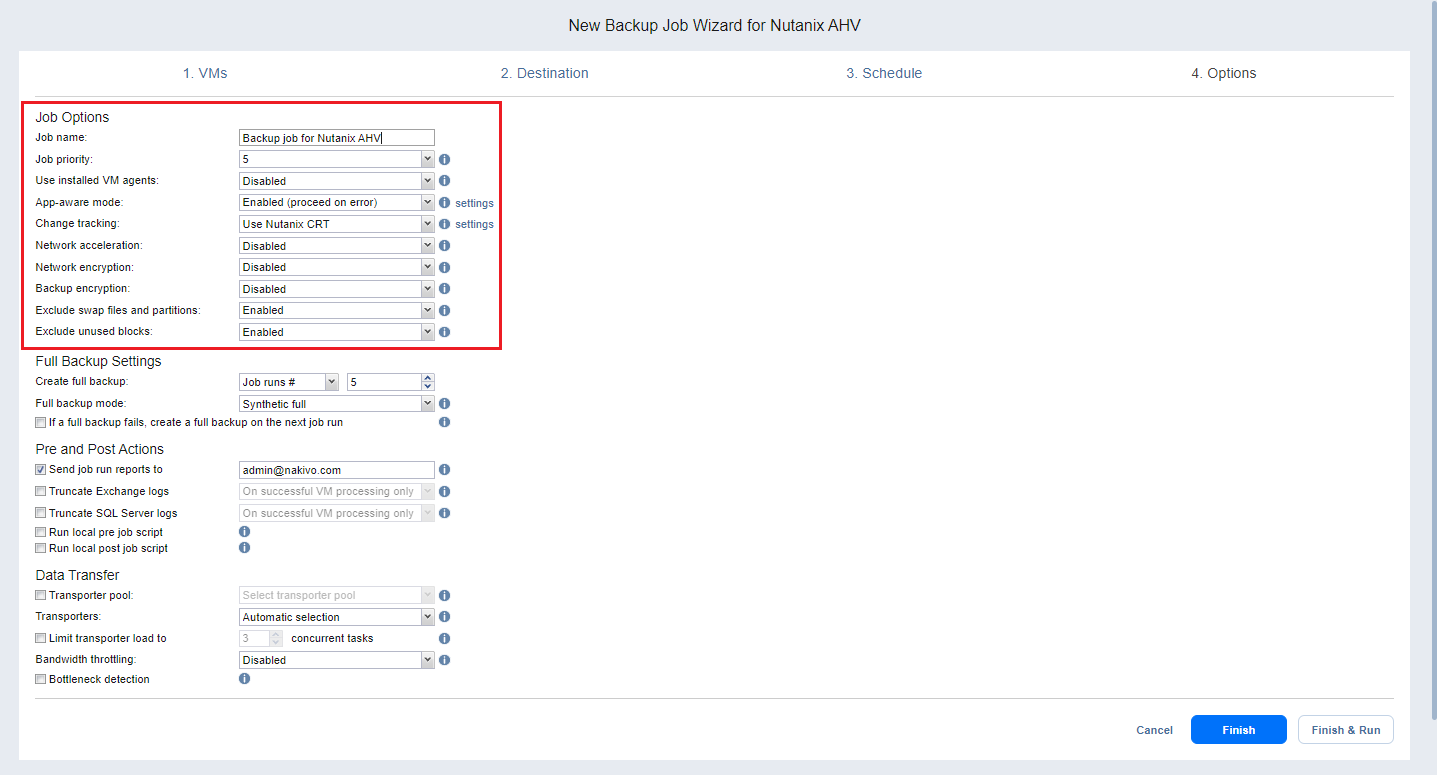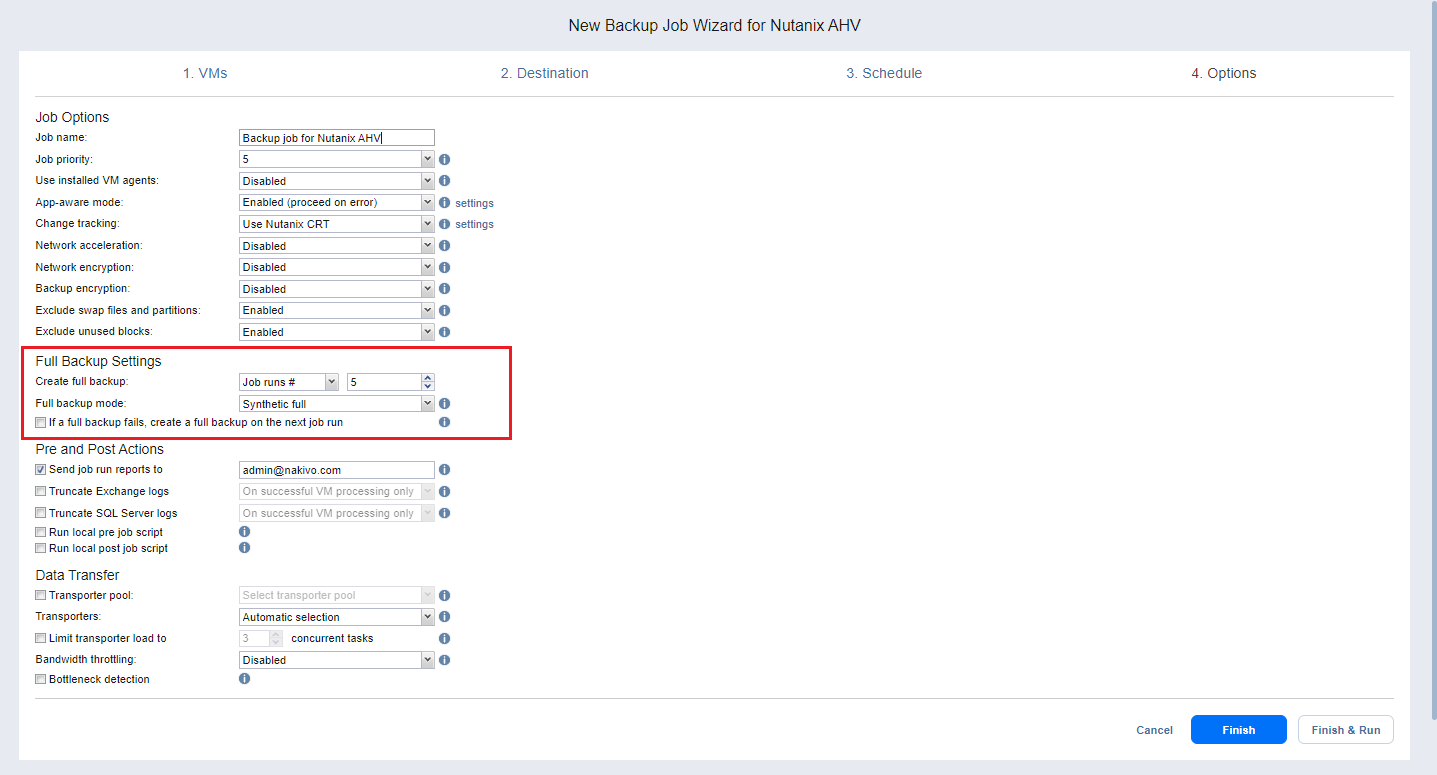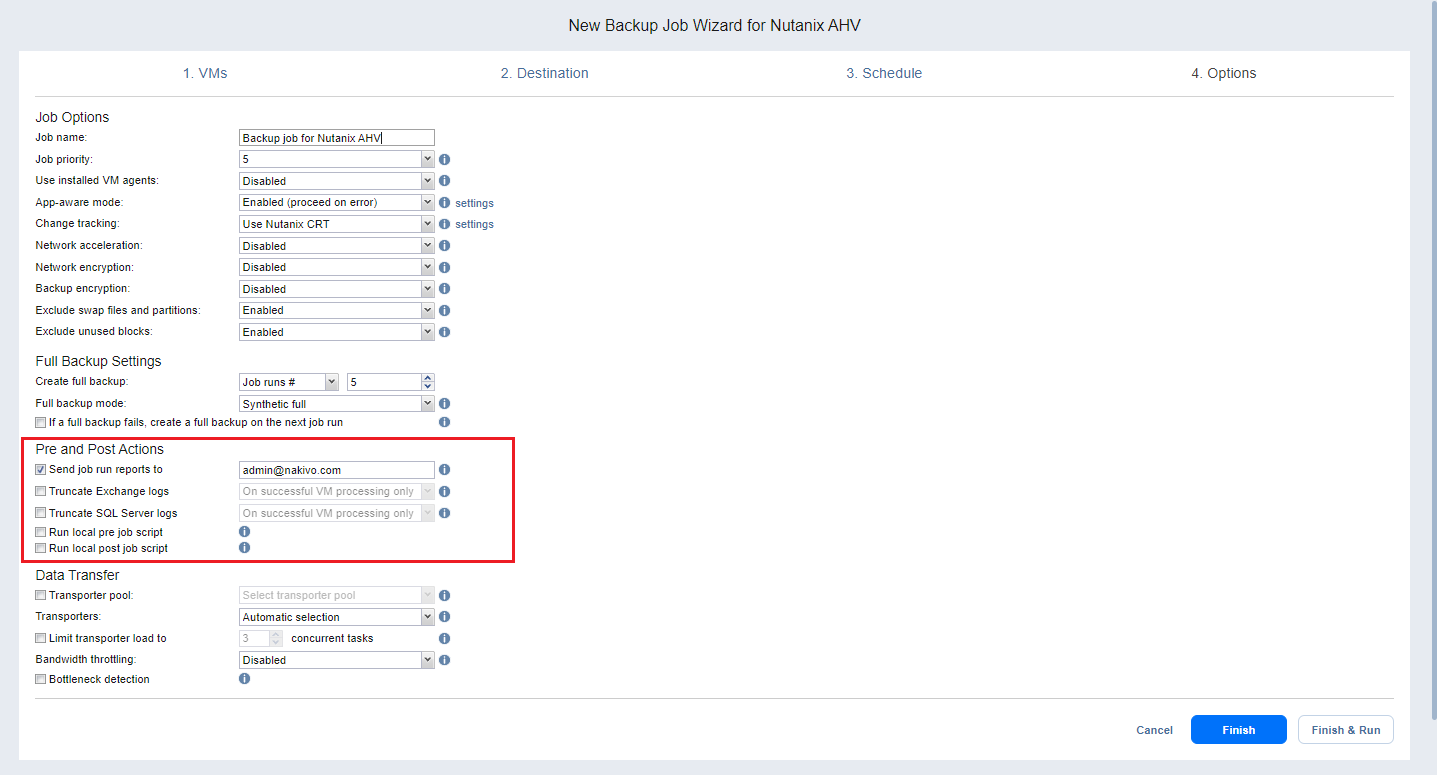Backup Job Wizard for Nutanix AHV: Options
On the Options page of the wizard, set up job options. Proceed as described in the sections below.
Job Options
Job Name
Enter the name of the backup job in the Job name box.
Job Priority
Select a job priority level between 1 and 5, with 1 being the highest priority. Jobs with higher priority levels are prioritized by Transporters during job processing.
Note
This option is only available in the Enterprise, Enterprise Essentials, Enterprise Plus, MSP Enterprise, and MSP Enterprise Plus editions.
Use Installed VM Agents
Enable this option if you wish to use installed VM agents for this job. Proceed as follows:
-
With the option enabled, click settings to open the Manage VM Agents pop-up menu.
-
Click Scan All to scan each VM in the job for installed VM agents.
-
Once the scan is complete, select the master password you wish to use for the discovered VM agents from the Select credentials drop-down list.
-
In the Certificate column, click Verify to verify the validity of a VM agent’s certificate.
For more information on setting up VM agents, see Using a VM Agent. For more information on setting up master passwords, see Managing Credentials.
App-aware Mode
If the App-aware mode option is enabled, VM backup will be performed using guest OS quiescing to ensure the consistency of application data. Please note that this feature requires the latest version of Nutanix Guest Tools to be installed on all source VMs. Processing of a VM can be set to continue or fail in case an application quiescing error is encountered.
Select one of the following options from the App-aware mode drop-down list:
-
Disabled: VM backup will be performed without application awareness.
-
Enabled (fail on error): Сlick settings and in the dialog box that opens, select checkboxes next to the VMs for which you want to create application-aware backups. When this option is selected, NAKIVO Backup & Replication will fail the backup if the app-aware mode fails.
-
Enabled (proceed on error): Click settings and in the dialog box that opens, select check boxes next to the VMs for which you want to create application-aware backups. When this option is selected, NAKIVO Backup & Replication will proceed with the backup even if the app-aware mode fails.
Change Tracking
Select one of the options from the Change tracking drop-down list:
-
No change tracking (always full): If this option is selected, NAKIVO Backup & Replication will always perform a full VM backup of all source VMs.
-
Use Nutanix CRT: If this option is selected, NAKIVO Backup & Replication will enable the Changed Region Tracking feature for source VMs. This feature enables the product to quickly identify which data regions have changed since the last job run, which significantly increases job speed. Click the settings link to specify additional options:
-
On error: Choose either of the following job behaviors in relation to Nutanix CRT error:
-
Switch to proprietary method: If Nutanix CRT fails to provide data on changed regions for a given VM and this option is selected, NAKIVO Backup & Replication will perform an incremental backup of that VM using the proprietary change tracking technology.
-
Fail VM processing: If Nutanix CRT fails to provide data on changed regions for a VM and this option is selected, NAKIVO Backup & Replication will not process that VM and will state job failure (other VMs in the job will be processed).
-
You can also specify when to switch or fail by selecting one of the available options: immediately, on the next retry or on the last retry.
-
-
-
Double-check changed blocks provided by CRT: If this option is selected, the changed data provided by the host will be additionally checked against the proprietary change tracking base. This approach is considered more reliable. It may perform more slowly, however, when compared to normal host-based change tracking.
-
Use proprietary method: If this option is selected, NAKIVO Backup & Replication will perform incremental backups using a proprietary change tracking technology. This feature requires the reading of contents of all VM disks to determine which data blocks have changed since the last job run.
Network Acceleration
If the Network Acceleration option is enabled, job data is transferred using compression and traffic reduction techniques, which can save the load on bandwidth while increasing the load on Transporters. Select this option if you transfer data over a slow WAN. Note that you need at least one Transporter on the source and target sites to enable network acceleration.
Note
The Network acceleration option is not available if the Backup encryption option is enabled.
Network Encryption
With the Network Encryption option enabled, VM data is protected with AES 256 encryption while traveling over the network. Data encryption increases the backup time and CPU load on machines running Transporters. Select this option if you are planning to back up over WAN without a VPN connection.
You need at least one Transporter at source and target sites to enable network encryption.
Backup Encryption
When enabled, backup data is protected with AES 256 block cipher encryption with a 256-bit key length. You can protect the backup file by creating a new password or selecting an existing one. For more information, refer to Enabling Backup Encryption.
Notes
This option is available only if the Disk or Tape destination type was chosen on the Destination page of the wizard.
The Backup encryption option is not available if the Network acceleration option is enabled.
If enabled, the created recovery points are encrypted.
The Backup encryption option is not displayed for a backup job where forever incremental repositories are selected as the only target repositories.
The Backup encryption option cannot be enabled if multiple targets with a mix of supported and unsupported (SaaS repositories or forever incremental repositories) repositories are selected as destinations.
It’s recommended that you enable the (AWS) Key Management Service. If KMS is enabled, all backup encryption passwords encrypted with the Key Management Service cryptographic key are available for recovery in case of product re-installation. For more information, refer to Enabling KMS.
Exclude Swap Files and Partitions
With this option enabled, NAKIVO Backup & Replication automatically excludes swap files and partitions during the backup process. This feature allows for creating smaller backups.
Full Backup Settings
If the type of the Backup Repository that you've selected on the Destination wizard page is set to Incremental with full backups (Store backups in separate files option is selected), you can specify the following options:
-
Create full backup: Specify how often full backups should be created.
-
Full backup mode: Specify how the full backup should be created. You can choose between the following options:
-
Synthetic full: If this option is selected, NAKIVO Backup & Replication will first perform an incremental backup (that is, will transfer only the data that changed since the last backup) and will then transform the available data into a full backup file. This approach has the following benefits:
-
The synthetic full backup is usually faster than the active full backup.
-
The load on the network is lower, as less data is transferred.
-
The load on the source datastores running your production VMs is lower.
-
-
Active full: If this option is selected, NAKIVO Backup & Replication will read all VM data from the source datastore and transfer it to the Backup Repository.
-
Pre and Post Actions
Email Notifications
NAKIVO Backup & Replication can send email notifications on job completion to specified recipients. This feature complements global notifications and provides you with the ability to configure notifications on a per-job level.
To enable this option, configure your Email settings.
To send email notifications, select Send job run reports to and specify one or more email addresses in the text box. The semi-colon character should be used to separate multiple email addresses.
Truncation of Microsoft Exchange Server Transaction Logs
Microsoft Exchange Server database transaction logs record all changes to an Exchange Server database. Over time, these log files accumulate and can consume all of the available disk space if not periodically removed. NAKIVO Backup & Replication provides an option to delete (aka truncate) Microsoft Exchange Server logs on the source VMs after job completion.
The transaction logs are deleted after the job is completed so that the log files are available in the VM backup. Note that the product deletes only those transaction logs which are already committed to (available in) the Microsoft Exchange database.
Note
Truncation is not supported for items added using Direct Connect.
To set up Microsoft Exchange log truncation, do the following:
-
Select the Truncate Exchange logs option.
-
In the dialog box that opens, select the checkboxes next to the VMs running Microsoft Exchange and then select the credentials next to each VM. These credentials will be used to log in to the VMs that you have selected.
Truncation of Microsoft SQL Server Transaction Logs
Microsoft SQL Server database transaction logs record all changes to an SQL Server database. Over time, these logs accumulate and can consume all of the available disk space if not periodically removed. NAKIVO Backup & Replication provides the option to delete (or truncate) Microsoft SQL Server logs on the source VMs after job completion.
The transaction logs are deleted after the job is completed so that the original log records are available in the VM backup. Note that the product deletes only those transaction logs that are already committed to (available in) the Microsoft SQL Server database.
Note
Truncation is not supported for items added using Direct Connect.
To set up Microsoft SQL Server log truncation, do the following:
-
Select the Truncate SQL Server logs option.
-
In the dialog box that opens, select the checkboxes next to the VMs running Microsoft SQL Server and then select credentials next to each VM. These credentials will be used to log in to the VMs that you have selected.
Pre Job Script
To run a script before the product begins backing up VMs, do the following:
-
Place a script file on the machine where the Director is installed.
-
Select the Run local pre job script option.
-
Specify the following parameters in the dialog box that opens:
-
Script path: Specify a local path to the script on the machine on which the Director is installed. Script interpreter should be specified.
Example (Windows): cmd.exe /c D:\script.batExample (Linux): bash /root/script.sh
-
Job behavior: Choose either of the following job behaviors in relation to script completion:
-
Wait for the script to finish: If this option is selected, VM backup will not be started until the script is completed.
-
Do not wait for the script to finish: If this option is selected, the product will run the script and will start backing up VMs at the same time.
-
-
Error handling: Choose either of the following job behaviors in relation to script failure:
-
Continue the job on script failure: If this option is selected, the job will perform VM backup even if the script has failed
-
Fail the job on script failure: If this option is selected and the script fails, the job will be failed and VM backup will not be performed.
-
-
Post Job Script
To run a script after the product has finished backing up all VMs, do the following:
-
Place a script file on the machine where the Director is installed.
-
Select the Run local post job script option.
-
Specify the following parameters in the dialog box that opens:
-
Script path: Specify a local path to the script on the machine on which the Director is installed. Script interpreter should be specified.
Example (Windows): cmd.exe /c D:\script.batExample (Linux): bash /root/script.sh
-
Job behavior: Choose either of the following job behaviors in relation to script completion:
-
Wait for the script to finish: If this option is selected, the job will be in the “running” state until the script is completed.
-
Do not wait for the script to finish: If this option is selected, the job will be completed even if the script execution is still in progress.
-
-
Error handling: Choose either of the following job behaviors in relation to script failure:
-
Continue the job on script failure: If this option is selected, script failure will not influence the status of the job.
-
Fail the job on script failure: If this option is selected and the script has failed, the job status will be set to “failed” even if the VM backup was successful.
-
-
Important
Pre and post job scripts can be executed only on the machine on which the Director is installed.
Data Transfer
In this section, you can select a transporter to be used for reading data from source VMs, specify a transporter load, and configure bandwidth throttling.
Transporter Pool
If this option is enabled, only the transporters that belong to the selected transporter pool shall be used during the job run.
Transporters
By default, the product automatically determines which Transporter should be used to read data from the source Instance. However, you can manually specify which Transporters should be used for the job.
In the Data Transfer section, choose one of the following options:
-
Automatic selection: The product will automatically determine which Transporters are the closest to source hosts (the hosts that run selected VMs) and will use those Transporters to retrieve data from source VMs.
-
Manual - configured for all VMs: Select this option to manually specify a single Transporter that will be used to retrieve data from source VMs.
-
Manual - configured per cluster: Select this option to manually specify which Transporter should be used to retrieve data from each source cluster. You can select the Automatic option to allow the system to select the closest Transporter.
-
For manually configured Transporters, clear the Auto select replacement transporters checkbox to explicitly lock the job to certain transporter(s)—otherwise, a replacement transporter will be picked automatically in case a Transporter is unavailable during the job start.
The target Transporter for the backup job will always be the Transporter assigned to the Backup Repository.
Transporter Load
You can limit the maximum number of transporter tasks used by the job. By default, it is set to 3 concurrent tasks.
To change the default number of tasks, do the following:
-
In the Data Transfer section, put the checkmark in the box next to Limit transporter load to.
-
Specify the number of concurrent tasks in the corresponding box.
Bandwidth Throttling
Follow the steps below to regulate the speed of data transfer over the network for your backup job:
-
For the Bandwidth throttling option, choose Enabled.
Note
If bandwidth throttling is disabled for the current job, global bandwidth rules may still apply to your job. Refer to Bandwidth Throttling for details.
-
Click the settings link that becomes available.
-
The Job Bandwidth Rules dialog box opens displaying the list of available rules. You have the following options:
-
Create a new bandwidth rule for your backup job:
-
Click the Create New Rule button.
-
The New Bandwidth Rule dialog box opens. Refer to the Bandwidth Throttling topic for details on creating a bandwidth rule.
-
Click Save.
-
-
Activate an existing bandwidth rule for your job. Select the checkbox to the left of the necessary bandwidth rule. To deactivate a bandwidth rule for your job, clear the corresponding checkbox.
-
Edit a bandwidth rule. Click the Edit link for a bandwidth rule and modify it in the Edit Bandwidth Rule dialog box that opens.
-
Disable a bandwidth rule. Click the Disable link. The bandwidth rule will be disabled for all jobs.
-
Remove a bandwidth rule. Click the Remove link and then click Delete to confirm your operation.
-
Bottleneck detection
When the Bottleneck detection option is enabled, additional information is collected and recorded in NAKIVO Backup & Replication logs in the course of data transfer for the purpose of bottleneck detection. Check this option to enable the Bottleneck detection capability of the Transporters engaged in the job.
Completing the New Backup Job Wizard for Nutanix AHV
Click Finish or Finish & Run to complete the job creation.
Note
If you click Finish & Run, you will have to define the scope of your job. Please refer to Running Jobs on Demand for details.



